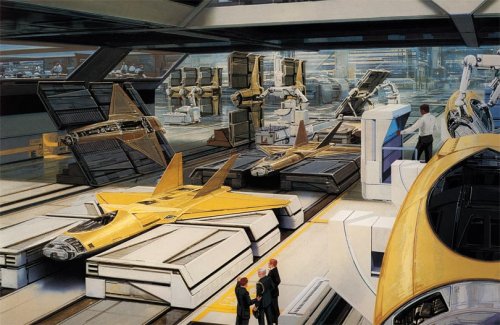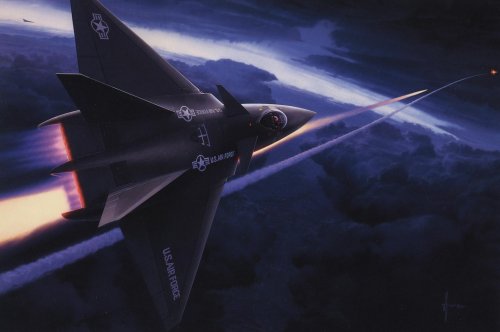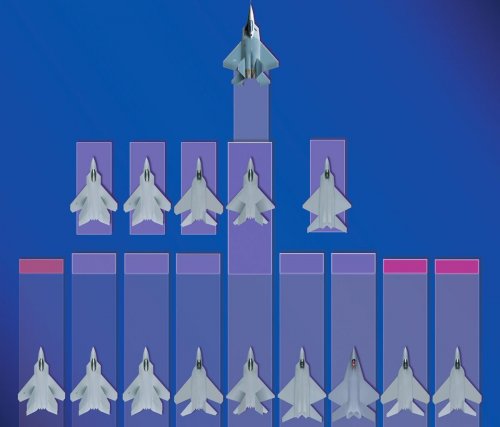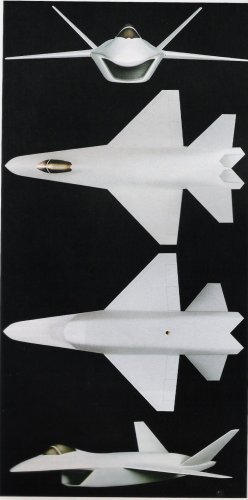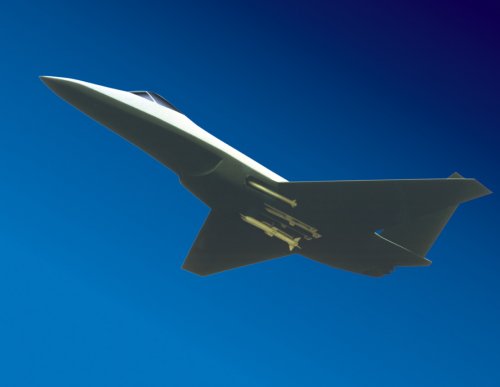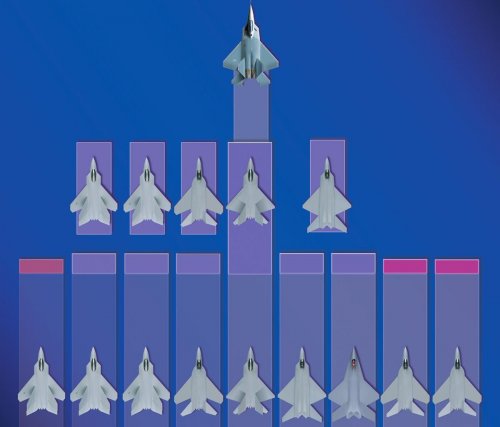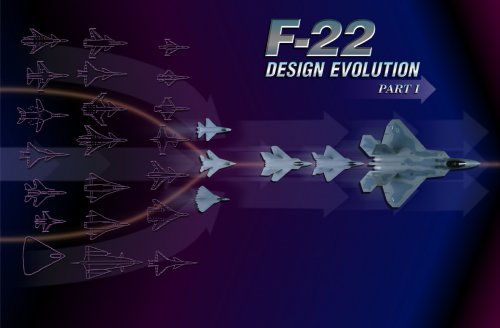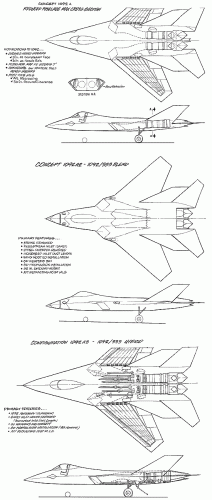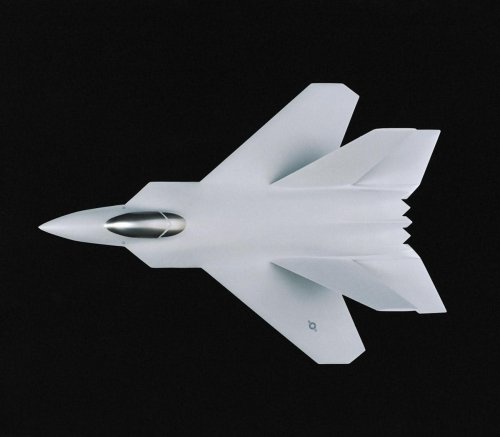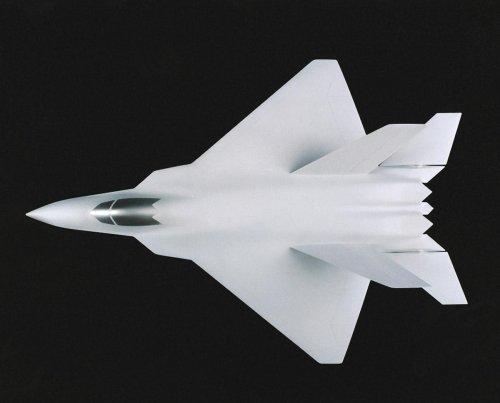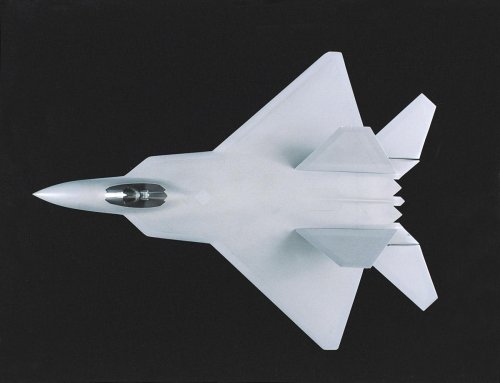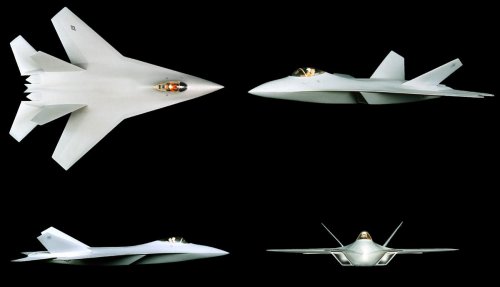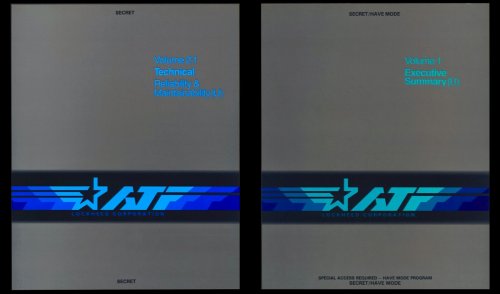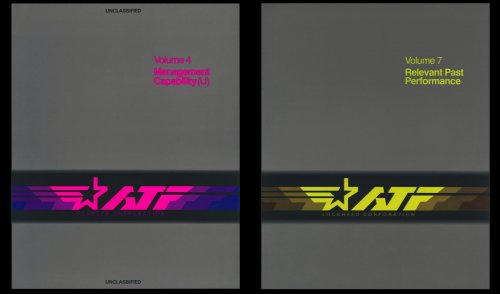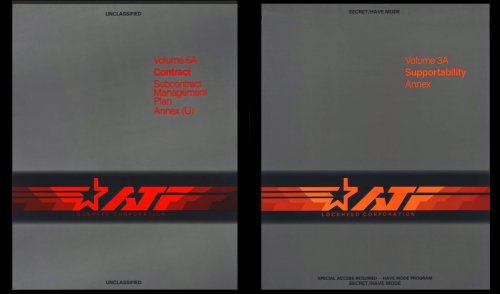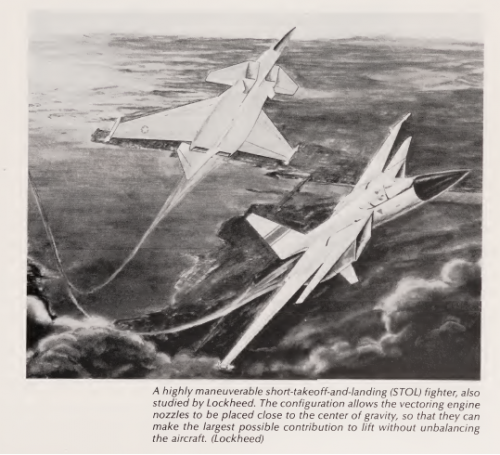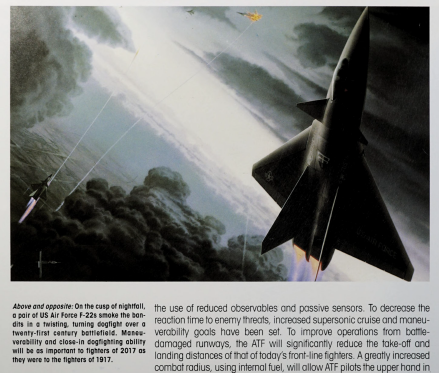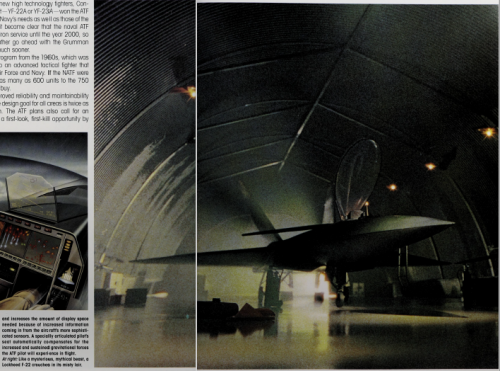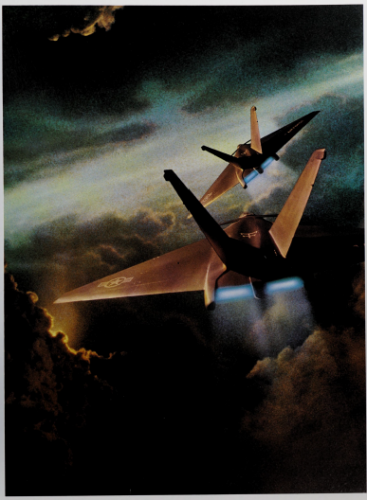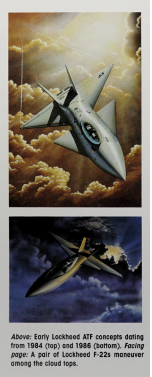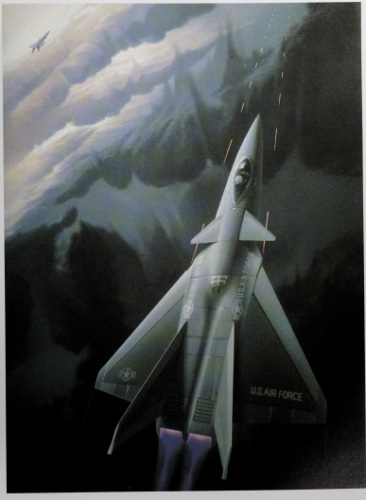You are using an out of date browser. It may not display this or other websites correctly.
You should upgrade or use an alternative browser.
You should upgrade or use an alternative browser.
Lockheed pre-ATF & ATF studies
- Thread starter flateric
- Start date
Rhinocrates
ACCESS: Top Secret
- Joined
- 26 September 2006
- Messages
- 2,112
- Reaction score
- 4,504
I attended a lecture by Syd Mead around about 1988 where he showed this. He said that - as is usual with illustration commissions - Lockheed guided quite closely the appearance they wanted for the aircraft. While it doesn't look exactly like any of the designs that led to the F-22, it does resemble some - but with key differences such as the canards. I wonder where the balance is struck between salesmanship and disinformation?
Attachments
- Joined
- 21 April 2009
- Messages
- 13,154
- Reaction score
- 6,012
Forward to F-23.netsferrin said:3rd from right on bottom row would seem to indicate LM didn't need to see the YF-23 in order to consider the butterfly tail and "trough" exhaust. So much for them "copying" the Yf-23s design.
- Joined
- 27 December 2005
- Messages
- 16,431
- Reaction score
- 19,060
sferrin said:3rd from right on bottom row would seem to indicate LM didn't need to see the YF-23 in order to consider the butterfly tail and "trough" exhaust. So much for them "copying" the Yf-23s design.
I believe that one and the one to its left are Boeing designs. Which makes sense, it has B-2 heritage like YF-23.
- Joined
- 27 December 2005
- Messages
- 16,431
- Reaction score
- 19,060
Not sure if serious...
You do remember that the YF-22 was designed by Lockheed, General Dynamics and Boeing?
The YF-22 represented a blending of 3 companies different design concepts. The two "YF-23ish" designs in the graphic look more related to Boeing's submission design than Lockheed's. My assumption is that these designs are derived from Boeing's submission design. Butterfly tail, exhaust troughs.... Note the other designs with the LERX from General Dynamics's ATF, and the configs very close to Lockheed's submission. This graphic shows the path from separate submissions to selected merged design.
You do remember that the YF-22 was designed by Lockheed, General Dynamics and Boeing?
The YF-22 represented a blending of 3 companies different design concepts. The two "YF-23ish" designs in the graphic look more related to Boeing's submission design than Lockheed's. My assumption is that these designs are derived from Boeing's submission design. Butterfly tail, exhaust troughs.... Note the other designs with the LERX from General Dynamics's ATF, and the configs very close to Lockheed's submission. This graphic shows the path from separate submissions to selected merged design.
Attachments
Last edited:
- Joined
- 27 December 2005
- Messages
- 16,431
- Reaction score
- 19,060
Boeing did a few butterfly tail pre-ATF designs too:


Last edited:
- Joined
- 27 December 2005
- Messages
- 16,431
- Reaction score
- 19,060
According to Sherman Mullin:
Boeing's design was the best of the second tier contenders.
Over the next several months we tried to determine the results of the competition.
Our best estimate was: (1) Lockheed; (2) Northrop, very close; (3) Boeing; (4) General Dynamics; and then the also-rans: McDonnell Douglas, Rockwell-North American Aviation, and Grumman. Neither of the two fighter incumbents had finished in the top three. The two leaders in stealth technology had won.
Boeing's design was the best of the second tier contenders.
- Joined
- 3 June 2011
- Messages
- 17,318
- Reaction score
- 9,043
PaulMM (Overscan) said:Not sure if serious...
You do remember that the YF-22 was designed by Lockheed, General Dynamics and Boeing?
GD and Boeing didn't enter the picture until after the down select (from 4 manufacturers to 2), at which point the two teams were formed. The designs in question (assuming the chart is chronological) came before that. Speaking of GD there was an interview (I believe with Mullen) in one of the Airtime Publishing books wherein he states one of the first things GD told LM is that their design (as presented) wouldn't even be able to fly. ;D The YF-22s final configuration resembles one of LMs earlier iterations. Will have to dig it up later.
PaulMM (Overscan) said:This graphic shows the path from separate submissions to selected merged design.
Pretty sure they're all LM designs, pre-teaming, as you don't see GD's sort-of delta wing anywhere.
- Joined
- 27 December 2005
- Messages
- 16,431
- Reaction score
- 19,060
Nope, pretty sure they are all designs from post teaming, and they were all done by merged teams of Lockheed/Boeing/GD engineers. Elements of all 3 proposals can be seen in the designs, and these two have clear elements from the Boeing design. The Boeing-influenced YF-23ish designs go forward further than the designs with GD look and contribute the diamond wing, while indeed many other elements of the final design are from the Lockheed heritage. I'm pretty sure given some effort were can merge the various timelines published and get a clearer idea.
Read Sherman Mullin's Winning the ATF for details on how the merged team threw everything they had done to date away in July 1987 and started again from scratch. It is a real disservice to the GD engineers and Boeing engineers to view the F-22 as a Lockheed design.
Read Sherman Mullin's Winning the ATF for details on how the merged team threw everything they had done to date away in July 1987 and started again from scratch. It is a real disservice to the GD engineers and Boeing engineers to view the F-22 as a Lockheed design.
- Joined
- 3 June 2011
- Messages
- 17,318
- Reaction score
- 9,043
PaulMM (Overscan) said:Nope, pretty sure they are all designs from post teaming, and they were all done by merged teams of Lockheed/Boeing/GD engineers. Elements of all 3 proposals can be seen in the designs, and these two have clear elements from the Boeing design. The Boeing-influenced YF-23ish designs go forward further than the designs with GD look and contribute the diamond wing, while indeed many other elements of the final design are from the Lockheed heritage. I'm pretty sure given some effort were can merge the various timelines published and get a clearer idea.
Read Sherman Mullin's Winning the ATF for details on how the merged team threw everything they had done to date away in July 1987 and started again from scratch. It is a real disservice to the GD engineers and Boeing engineers to view the F-22 as a Lockheed design.
My assumption was based on the graphic appearing to have strictly LM designs. There's nothing on that picture that specifically indicates Boeing involvement at that stage. If you have other supporting documents I'd love to see them. I'm well aware (as I indicated in the previous post) that the design LM won with is not the one that got built, but GD and Boeing didn't get involved until after the down select. Do you have another source somewhere that indicates #3 and #4 from the right on the bottom row are Boeings?
Attachments
- Joined
- 21 April 2009
- Messages
- 13,154
- Reaction score
- 6,012
Regardless of how this debate plays out it does indicate that the LM 6th Generation planform was never unique to the F-23 and F-23.net claim of copying, and therefore proving the F-23 superior, is not entirely accurate.sferrin said:PaulMM (Overscan) said:Nope, pretty sure they are all designs from post teaming, and they were all done by merged teams of Lockheed/Boeing/GD engineers. Elements of all 3 proposals can be seen in the designs, and these two have clear elements from the Boeing design. The Boeing-influenced YF-23ish designs go forward further than the designs with GD look and contribute the diamond wing, while indeed many other elements of the final design are from the Lockheed heritage. I'm pretty sure given some effort were can merge the various timelines published and get a clearer idea.
Read Sherman Mullin's Winning the ATF for details on how the merged team threw everything they had done to date away in July 1987 and started again from scratch. It is a real disservice to the GD engineers and Boeing engineers to view the F-22 as a Lockheed design.
My assumption was based on the graphic appearing to have strictly LM designs. There's nothing on that picture that specifically indicates Boeing involvement at that stage. If you have other supporting documents I'd love to see them. I'm well aware (as I indicated in the previous post) that the design LM won with is not the one that got built, but GD and Boeing didn't get involved until after the down select. Do you have another source somewhere that indicates #3 and #4 from the right on the bottom row are Boeings?
- Joined
- 27 December 2005
- Messages
- 16,431
- Reaction score
- 19,060
This is Lockheed's pre-teaming submission. It clearly pre-dates all the designs on the chart. Therefore all the designs on this chart are post-teaming. I'm not saying those designs are Boeing: they are team designs but use major elements of Boeing's pre-teaming submission. Designs 4 8 and 9 (from left) show elements of GDs design in LERX and probably intakes (though not visible).
Last edited:
Steve Pace
Aviation History Writer
- Joined
- 6 January 2013
- Messages
- 2,266
- Reaction score
- 167
From where did you acquire this pre-teaming ATF illustration, Paul? -SP
- Joined
- 3 June 2011
- Messages
- 17,318
- Reaction score
- 9,043
PaulMM (Overscan) said:
This is Lockheed's pre-teaming submission. It clearly pre-dates all the designs on the chart. Therefore all the designs on this chart are post-teaming.
Except that it doesn't. So they aren't. According to Jay Miller's book on the F-22 that configuration was but one of four LM considered at that phase of the program. Two of the four are present on the chart we've been discussing. See below:

The lower left is obviously of the same design iteration line. The upper right is very close to that in the graphic as well. The lower right is, as you point out, the one that won. The upper left is the one I indicated in a previous post resembles the final YF-22 design.
Last edited by a moderator:
- Joined
- 3 June 2011
- Messages
- 17,318
- Reaction score
- 9,043
Steve Pace said:From where did you acquire this pre-teaming ATF illustration, Paul? -SP
If you're referring to the chart it came from there.
- Joined
- 22 October 2006
- Messages
- 337
- Reaction score
- 58
Regardless of how this debate plays out it does indicate that the LM 6th Generation planform was never unique to the F-23 and F-23.net claim of copying, and therefore proving the F-23 superior, is not entirely accurate.
This actually means nothing (i mean the fact that boeing studied two tails). First, in the boeing the horizontal stabilizers were gone probably because of TVC. Their cant is not sufficient to be ruddervators like in the YF-23.
Second, a plane is not just a collection of features but an integral system. What works on one plane may not work on another.
Third you don't know why LM discarded it. Sometimes you can discard better performing design. IIRC, LM discarded the design that has a triangular nose (the lerx ran to the nose) because they couldn't get satisfactory stability despite the design being promising.
Now where i join you is that i find supacruze comment very unprofessionnal as somewhat point out. Just because the plane (which is a concept art by the way) as Vtails and decked nozzles doesn't mean it is a rip off the F-23
This actually means nothing (i mean the fact that boeing studied two tails). First, in the boeing the horizontal stabilizers were gone probably because of TVC. Their cant is not sufficient to be ruddervators like in the YF-23.
Second, a plane is not just a collection of features but an integral system. What works on one plane may not work on another.
Third you don't know why LM discarded it. Sometimes you can discard better performing design. IIRC, LM discarded the design that has a triangular nose (the lerx ran to the nose) because they couldn't get satisfactory stability despite the design being promising.
Now where i join you is that i find supacruze comment very unprofessionnal as somewhat point out. Just because the plane (which is a concept art by the way) as Vtails and decked nozzles doesn't mean it is a rip off the F-23
- Joined
- 27 December 2005
- Messages
- 16,431
- Reaction score
- 19,060
Agreed. Scott, the Jay Miller book has a few mistakes in this area which I can confirm later when I have access.
- Joined
- 3 June 2011
- Messages
- 17,318
- Reaction score
- 9,043
PaulMM (Overscan) said:Agreed. Scott, the Jay Miller book has a few mistakes in this area which I can confirm later when I have access.
Fair enough. (I can think of a few off the top of my head.)
- Joined
- 27 December 2005
- Messages
- 16,431
- Reaction score
- 19,060
- Joined
- 27 December 2005
- Messages
- 16,431
- Reaction score
- 19,060
So, Jay Miller's book completely fails to identify any kind of sequence generally, and a lot of General Dynamics designs are just labelled as Lockheed Martin. He fails to distinguish between the pre-teaming and post-teaming designs. He does have quite a lot of designs. Given some time I can probably put together something like my "F-15 Evolution" chart for the F-22.
Last edited:
- Joined
- 27 December 2005
- Messages
- 16,431
- Reaction score
- 19,060
- Joined
- 27 December 2005
- Messages
- 16,431
- Reaction score
- 19,060
- Joined
- 27 December 2005
- Messages
- 16,431
- Reaction score
- 19,060
- Joined
- 27 December 2005
- Messages
- 16,431
- Reaction score
- 19,060
- Joined
- 27 December 2005
- Messages
- 16,431
- Reaction score
- 19,060
- Joined
- 27 December 2005
- Messages
- 16,431
- Reaction score
- 19,060
Submissions
Boeing 864
General Dynamics 333
Lockheed 090P
These lead to 092.
Then it seems that YF-22 demonstrator and F-22 EMD proposal begin to diverge with 595 (EMD) & 1095 (demonstrator).
This design is rejected July 1987, not good enough.
We have drawings of 1095A1/A2/A3 variations, date not certain.
There are various designs proposed, by October 1987 614 is the new baseline with 1114 its YF-22 counterpart. Other designs we know of: 612, 613, 615. November 1987, 631/1131. Minor tweaks produce 632 / 1132 by April 1988 and 1132 is frozen as the YF-22 demonstrator. F-22 then continues to evolve through 634, 637, 638 being the EMD F-22 proposal, end of 1989.
I think 612 is one of the "Boeingish" designs, 613 the "GDish" design, 615 the "Lockheedish" 1095 descendent but I can't however definitively assign models to all the designs the chart in question due to the low quality drawings, so its not yet settled
Last edited:
- Joined
- 27 December 2005
- Messages
- 16,431
- Reaction score
- 19,060
We decided to start over at the crack of dawn on Monday, July 13. Thus, the F-22 Advanced Tactical Fighter was born between July 13 and mid October — in a 90-day fire drill. Our team looked at every possible configuration of the aircraft we could imagine. We formed separate tri-company teams in Burbank to do preliminary design for each candidate aircraft and to estimate its weight, combat performance, and other characteristics. We absolutely refused to compromise in the area of low observability. Any candidate design which was not really stealthy was immediately dropped. We worked six- and seven-day weeks. Tempers often flared, but the work went on.
The options and decisions seemed endless. We debated such things as whether to go with two big tails or four smaller tails, or different engine air inlets, or different wings, or different internal weapons bays with different kinds of weapons bay doors. We worried over weight estimates and drag estimates. However, one thing did not change: The designs always included LO engine nozzles with pitch thrust vectoring. Our team continued to work intensely with General Electric and Pratt & Whitney to make this happen. Heppe was one of the great aeronautical engineers of his generation, and, at 64, he demonstrated that one more time during that intense summer of 1987. He had been at Lockheed since 1947, after completing postgraduate work at the California Institute of Technology in Pasadena. He understood both supersonic aerodynamics and stealth in great depth. He personally made all the major decisions. The rest of us supported him and Cantrell intensely.
It was a summer of imagination, invention, and engineering achievement. By Oct. 15, we believed we had converged on the best aircraft design we could conceive. It had the lightest weight and the best operational fighter performance. We froze the external geometry—known in the aircraft business as freezing the lines—and launched the very talented Lockheed-Boeing-General Dynamics YF-22A prototype design engineering team. Our technical course to winning was set. However, three years of intense systems engineering and detailed design engineering of the F-22 production aircraft were still ahead. And, the results of the great 90-day fire drill were not perfect. It was in April 1988, that Edsel “Ed” Glasgow, our Chief Flight Sciences Engineer and one of the true fathers of the F-22, told me that our prototype aircraft would not supercruise. He said that the supersonic aerodynamic drag at Mach 1.5 was too high. Shocked, I snapped at him, “Don’t tell me our damned problems; tell us how to fix them.” The next day he did.
The options and decisions seemed endless. We debated such things as whether to go with two big tails or four smaller tails, or different engine air inlets, or different wings, or different internal weapons bays with different kinds of weapons bay doors. We worried over weight estimates and drag estimates. However, one thing did not change: The designs always included LO engine nozzles with pitch thrust vectoring. Our team continued to work intensely with General Electric and Pratt & Whitney to make this happen. Heppe was one of the great aeronautical engineers of his generation, and, at 64, he demonstrated that one more time during that intense summer of 1987. He had been at Lockheed since 1947, after completing postgraduate work at the California Institute of Technology in Pasadena. He understood both supersonic aerodynamics and stealth in great depth. He personally made all the major decisions. The rest of us supported him and Cantrell intensely.
It was a summer of imagination, invention, and engineering achievement. By Oct. 15, we believed we had converged on the best aircraft design we could conceive. It had the lightest weight and the best operational fighter performance. We froze the external geometry—known in the aircraft business as freezing the lines—and launched the very talented Lockheed-Boeing-General Dynamics YF-22A prototype design engineering team. Our technical course to winning was set. However, three years of intense systems engineering and detailed design engineering of the F-22 production aircraft were still ahead. And, the results of the great 90-day fire drill were not perfect. It was in April 1988, that Edsel “Ed” Glasgow, our Chief Flight Sciences Engineer and one of the true fathers of the F-22, told me that our prototype aircraft would not supercruise. He said that the supersonic aerodynamic drag at Mach 1.5 was too high. Shocked, I snapped at him, “Don’t tell me our damned problems; tell us how to fix them.” The next day he did.
Last edited:
- Joined
- 27 December 2005
- Messages
- 16,431
- Reaction score
- 19,060
Here's something interesting... and terribly dated in appearance. If only we had more pages....
Source: http://johnmberman.blogspot.co.nz/2013/03/lockheed-aircraft.html (thanks to flateric)
Source: http://johnmberman.blogspot.co.nz/2013/03/lockheed-aircraft.html (thanks to flateric)
Attachments
- Joined
- 26 May 2006
- Messages
- 32,664
- Reaction score
- 11,859
- Joined
- 3 June 2011
- Messages
- 17,318
- Reaction score
- 9,043
hesham said:From; Warplanes of the 21st Century,
in picture No13,was it a mock-up for it or what ?.
No, that's artwork not a photo. Hadn't seen #12 before.
FighterJock
ACCESS: Top Secret
- Joined
- 29 October 2007
- Messages
- 4,202
- Reaction score
- 3,379
One thing that is bothering me, was there once a Lockheed ATF design that looked almost like a mini SR-71? I can't remember where I saw it exactly. :-\
- Joined
- 1 April 2006
- Messages
- 10,725
- Reaction score
- 6,730
User ArtworkFighterJock said:One thing that is bothering me, was there once a Lockheed ATF design that looked almost like a mini SR-71? I can't remember where I saw it exactly. :-\
Project
Last edited by a moderator:
FighterJock
ACCESS: Top Secret
- Joined
- 29 October 2007
- Messages
- 4,202
- Reaction score
- 3,379
Thanks flateric, now I know that it even had a internal Lockheed designation.
Last edited by a moderator:
- Joined
- 2 August 2006
- Messages
- 3,173
- Reaction score
- 1,153
FighterJock said:One thing that is bothering me, was there once a Lockheed ATF design that looked almost like a mini SR-71? I can't remember where I saw it exactly. :-\
You might also be thinking of these designs, especially the first one, that was part of the original design studies for a strike fighter, as opposed to a stealthy air superiority fighter. These were put up by Flateric further up thread, but they were shown in many books and magazines back in the 1980's.
Last edited by a moderator:
Similar threads
-
-
-
Finalized Rockwell ATF Design?
- Started by Kryptid
- Replies: 69
-
NATF: planned Navy versions of the F-22 and F-23
- Started by Maki
- Replies: 270
-
Pre-ATF fighter study with stores mounted on top of the fuselage? Can't find it.
- Started by AeroFranz
- Replies: 10

